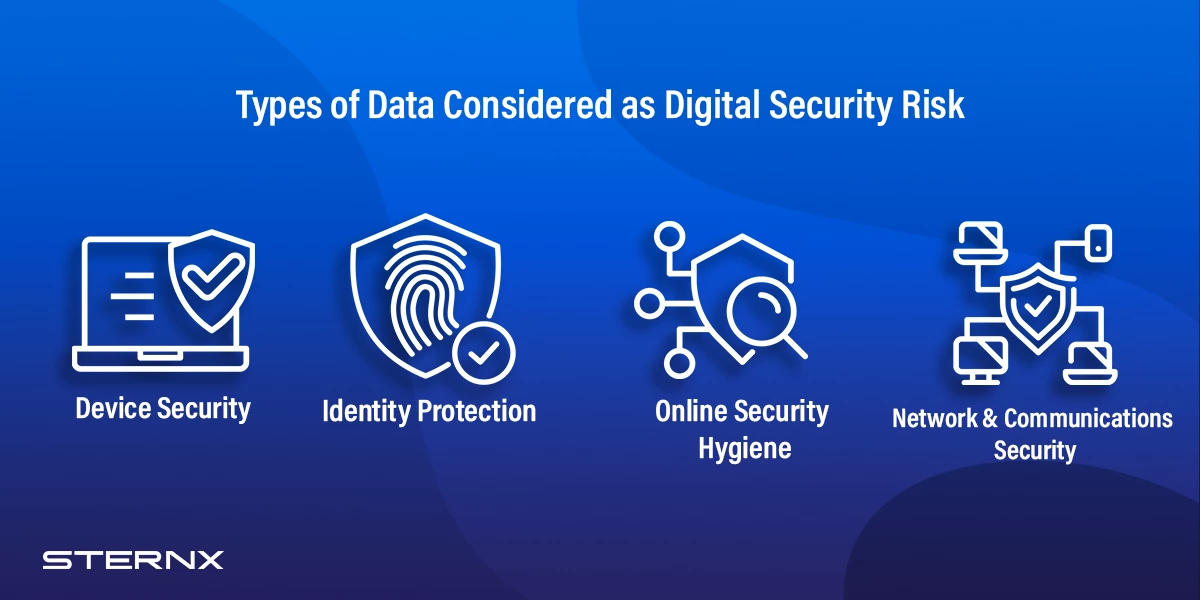Table of Contents
In our increasingly interconnected world, digital security has become more important than ever. The pandemic opened our eyes to a world where a significant portion of our daily activity can be done online and it is amazing how this continued even after the pandemic.
Today, we live in a time where much of our lives, personal and professional, reside online. We do our banking, music purchases, bill paying, social planning, and even parts of our job are online. Unfortunately, the increased activities have also made us more vulnerable to hackers and scammers. That is why we need to protect ourselves by implementing proper digital security measures.
In the article, you will learn:
- What digital security and why it is Important
- The difference between cybersecurity and digital security
- Key areas of digital security
- Different types of digital security tools
- Types of data considered as digital risk
- How to protect yourself with digital security
What is Digital Security?
Digital security refers to the protections and practices we employ to secure our data, devices and online presence from unauthorized access, theft or damage. This includes measures to guard against threats like hacking, identity theft, malware attacks, online scams and breaches of private information.
Robust digital security requires implementing tools like antivirus software, VPNs and firewalls to create barriers to entry. It also means practicing habits like using strong passwords with two factor authentication, applying software updates promptly and recognizing suspicious links or attachments that could introduce threats. Education is also key — understanding common risks makes it possible to proactively minimize them.

Why is Digital Data Security Important?
Digital data security is crucial for safeguarding sensitive information from unauthorized access, theft, or manipulation. Think of digital security as a Genie that protects you from cyber threats, data breaches, identity theft, financial fraud, and reputational damage.
It’s quite common to mix up the terms “cyber security” and “digital security,” but there is indeed a distinction between the two.
What is the Difference Between Cybersecurity and Digital security?
Cyber security is the practice of protecting computers, networks, and data from unauthorized access, use, disclosure, disruption, modification, or destruction. It is a broader term that encompasses all aspects of protecting digital information and systems, including hardware, software, networks, and data.
Digital security, on the other hand, is a more specific term that refers to the protection of digital data and information. Think of it as a branch of cyber security.
Examples of cyber security measures:
- Implementing firewalls and intrusion detection systems
- Using strong passwords and encryption
- Training employees on security awareness
- Backing up data regularly
- Having a disaster recovery plan in place
Examples of digital security measures:
- Encrypting data at rest and in transit
- Controlling access to data
- Implementing data loss prevention measures
- Monitoring data for unauthorized access or use
What is the Difference Between Digital Security and Digital Privacy?
Digital security primarily deals with safeguarding digital assets and protecting them from unauthorized access, data breaches, and other forms of cyber threats. It involves implementing security measures such as encryption, strong passwords, firewalls, antivirus software, and secure network protocols.
Examples of digital security:
- Two-factor authentication: Requiring an additional verification step, such as a unique code sent to a mobile device, along with a password, adds an extra layer of security to online accounts.
- Data encryption: Encrypting sensitive data ensures that even if it is intercepted, it remains unreadable and unusable without the encryption key.
- Regular software updates: Keeping software and operating systems up to date helps patch security vulnerabilities and protect against known exploits.
Digital privacy, on the other hand, focuses on an individual’s control over their personal information and how it is collected, stored, and used by various entities. In digital privacy, your data is prevented from being accessed, shared, or used without your consent.
Examples of digital privacy practices include:
- Strong privacy settings: Adjusting privacy settings on social media platforms, web browsers, and other online services to limit the sharing of personal information and control who can access it.
- Using a virtual private network (VPN): A VPN establishes an encrypted connection between a device and the internet, ensuring that online activities remain private and protected from surveillance.
- Anonymous Browsing: Utilizing private browsing modes or browser extensions that block tracking cookies and prevent websites from collecting personal information. Chrome offers this feature with its incognito mode.
Which Data is Considered a Digital Security Risk and How To Stay Protected in 2024
There are a few major categories where digital security vulnerabilities tend to arise:
Device Security
Securing the various computing devices we use daily is crucial. Whether it’s a laptop, smartphone or tablet, the device itself needs protection. This means installing security and antivirus software, monitoring and location tracking app, setting lock screens, promptly applying updates and patches to fix bugs, avoiding public WiFi for sensitive activities, and preventing unauthorized physical access to the device.
Identity Protection
Our digital identities are extremely valuable — personal details like names, birthdates, locations and Social Security numbers can facilitate identity theft and financial fraud. It’s critical to carefully protect any accounts tied to our identities, use unique passwords for each, limit what personal information we share publicly online, and be vigilant about phishing attempts trying to steal credentials or personal information.
Online Security Hygiene
Being generally cautious about malware, suspicious links, unusual logins to accounts and potential indicators of hacking/phishing attempts go a long way towards good digital hygiene. Paying attention to website URLs, double checking sender addresses on emails, logging out of public computers and not connecting storage devices from an unreliable source are simple habits anyone can build.
Network & Communications Security
There are also protective measures individuals may not always think of, but SOHO’s (small offices, home offices) and buildings at large should utilize — like installing firewalls, VPNs, and WiFi encryption protocols to ensure corporate equipment and networks are not remotely accessible by unauthorized users.
What are the Different Types of Digital Security?
Encryption:
This type of digital security converts data into a coded format, making it unreadable to unauthorized users without the decryption key. It protects sensitive data, such as financial information, medical records, and trade secrets.
Firewalls:
Another type of digital security is firewalls. It acts as a barrier between a trusted internal network and untrusted external networks, such as the Internet. They control incoming and outgoing network traffic and can block unauthorized access to the internal network.
Antivirus software for Digital Security:
Aside from firewalls, antivirus software is another type of digital security software. It detects and removes malicious software, such as viruses, worms, and trojans, from computers and networks. Malicious software can be used to steal data, damage systems, or launch attacks.
Parental Control Software for Digital Security:
Parental control is a form of application security specifically designed to protect children online. In parental control software, a control function is integrated to allow parents,
- Limit screen time: Manage how much time children spend on devices.
- Filter content: Block access to inappropriate websites and content.
- Monitor app usage: Track what apps children are using and for how long.
- Control in-app purchases: Restrict children from making unauthorized purchases within apps.
A good example of this software is the Safes Parental Control App
Multi-factor authentication
Multi-factor authentication also known as (MFA), adds an extra layer of security to online accounts. It does this by requiring users to provide multiple forms of verification, such as a password, a security token, or a fingerprint scan. This makes it more difficult for attackers to gain access to accounts, even if they have stolen your password.
Secure Sockets Layer (SSL)/Transport Layer Security (TLS)
This type of software encrypts data transmitted between web servers and browsers. It is used for protecting sensitive data, such as credit card numbers and passwords, from being intercepted and stolen by attackers. As a rule of thumb, you should be careful when you click on a site without the SSL certificate. I will advise you not to include important details when on these sites. This is because your details are not encrypted when being transmitted to the server. Hackers can intercept the transmission process and steal your information. You can identify them with a “not secure” warning from Google.
What Are Some Specific Examples of Digital Security Tools?
There are millions of tools available for digital security enhancement, and sometimes it can be difficult to classify them. It can be more difficult if you are a newbie in the digital space.
Password Managers:
Password managers are tools or software applications that securely store and manage passwords for various online accounts. Password managers can do two things for you.
- They eliminate the need to remember multiple passwords by securely storing them in an encrypted database.
- Password managers also generate strong, unique passwords for different accounts, ensuring better security and reducing the risk of password-related security breaches.
Virtual Private Networks (VPNs):
VPNs are services that provide a secure and private connection between a user’s device and the internet. It is one of the most common digital security tools.
How do they work?
- They encrypt internet traffic, making it unreadable to anyone trying to intercept it.
- VPNs also conceal the user’s IP address, which helps protect their privacy and enhances security while browsing online.
Intrusion Detection Systems (IDS):
Another example of a digital security tool is IDS. They work by monitoring network traffic for any suspicious activities or unauthorized access attempts. They also analyze network packets and compare them against known attack signatures or abnormal behavior patterns. If an intrusion or security threat is detected, IDS can generate alerts or take automated actions to mitigate the threat.
Data Loss Prevention (DLP) Software:
Unlike Intrusion Detection Systems, DLP software is designed to prevent hackers by monitoring data in motion, at rest, and in use within your organization’s network.
How does it work?
- DLP software uses various techniques such as content inspection, contextual analysis, and user behavior monitoring to detect and prevent data leaks.
- Additionally, DLP enforces policies, blocks or encrypt sensitive data, and generates alerts when potential data breaches occur.
- This will, in turn, help your organization protect your valuable data assets before it is too late.
Biometric Authentication Systems
Biometric authentication systems use unique biological characteristics or traits of individuals to verify their identities securely. Some of these traits include fingerprint scanners, facial recognition systems, iris scanners, and voice recognition.
How does it work?
Once placed close to the biological traits for verification,
- These systems capture and analyze biometric data to authenticate users before granting access to sensitive systems or data.
- Biometric authentication is considered higher than the traditional password manager because biometric traits are difficult to replicate or forge.

Why Practice Caution with Digital Security?
Cyber threats exist as long as the internet exists in its current form — and by extension, as long as we increasingly digitize different aspects of business, infrastructure, and personal lives. Paying attention to digital security risk helps:
- Minimize risk of data, identity theft, financial fraud or account compromise
- Reduce malware infections that cause device performance issues or loss of data
- Prevent access by malicious actors seeking proprietary business information
- Maintain user privacy and safety, especially for children
- Give individuals and parents peace of mind about online practices
Effective Digital Security Starts with Individual Diligence
While robust cyber security requires technological solutions as well, human judgment calls cannot be replaced. By cultivating consistent habits around digital literacy and caution online, individuals can empower themselves to identify many attempted attacks.
IT solution company or IT department cannot eliminate threats entirely; it will always come down to being alert and mindful whenever we go online. Paying attention to the sites we visit, files we download, attachments we open and access we grant ultimately contributes to everyone’s safety and security online. The good news is basic diligence goes a very long way. While cyber criminals deploy increasingly sophisticated tactics, the vast majority rely on human error and exploitation of our inclination to trust. Merely verifying the trustworthiness of a source before downloading a file or providing credentials can prevent many dangerous breaches.
An Ongoing Process
Digital security is not a one-and-done practice; it requires regular maintenance and awareness just like any discipline. As cyber threats evolve, so must our protective software, firewall settings, login protocols and personal habits. Technology not upgraded eventually becomes obsolete; we must view security in the same way.
There is no perfect impenetrable solution. The key is layering defensive measures via both technical tools and ongoing human discernment – a combination that collectively reduces our level of risk substantially. With vigilance, common sense and proactive precautions taken by individuals and organizations alike, we can maintain effective security appropriate for our needs.
The connectivity we enjoy in our digital lives has opened doors for convenience as well as threats. But when we understand the principles behind digital security fundamentals, implement key protective tools and maintain consistent caution in online activities, individuals and businesses can thrive safely.

